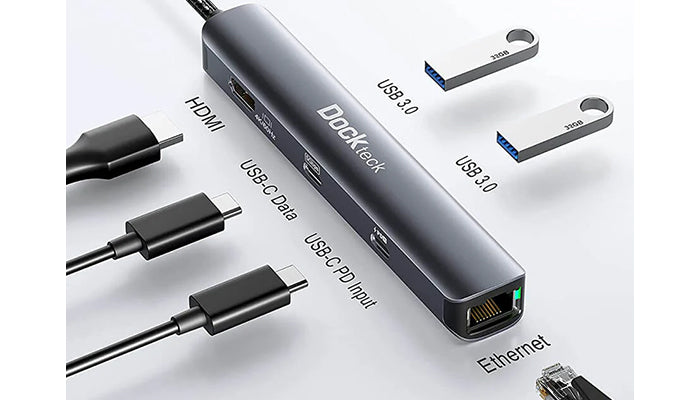People who know nothing about USB-C ports and their video output capabilities will be particularly embarrassed when encountering these technical issues. Don’t worry, Dockteck will delve into the world of USB-C hubs with you and reveal device compatibility and port specifications. and the mystery behind the important role of additional adapters or cables.
USB-C: The versatile connection for modern devices
USB-C has been hailed as the universal connector of the future, offering countless possibilities for connecting a variety of devices. With its compact size and reversible design, USB-C ports have become very common in electronic products such as laptops, smartphones, and tablets. However, not all USB-C ports are created equal when it comes to video output capabilities.Determining device compatibility is key
Device compatibility is an important consideration when exploring the video output capabilities of USB-C ports. While most devices are equipped with USB-C ports, not all devices support video output. So be sure to check your device's specs to confirm whether it's equipped with a video-capable USB-C port. Generally, devices such as laptops, tablets, and smartphones support video output through USB-C, making it easier for users to connect external monitors, projectors, and other devices to improve work efficiency and entertainment experience.Explore the differences in port specifications
USB-C ports come in a variety of sizes, each offering a different level of video output functionality. Equipped with a high-quality USB-C port with DisplayPort Alt mode or Thunderbolt 3 support, it can output a powerful video signal, allowing users to enjoy clear picture quality on external displays with resolutions up to 4K or even 8K. However, devices with only standard USB-C ports may have limited video output capabilities, leaving users limited to lower resolutions or refresh rates.What a USB-C hub does: Enhance your video connection
To fully utilize the video output potential of a USB-C port, users often choose to use a USB-C hub. These versatile devices act as a bridge between USB-C enabled devices and external displays, expanding connectivity options by providing additional ports and features. A USB-C hub equipped with HDMI, DisplayPort or VGA output allows users to seamlessly connect a variety of display devices such as monitors, TVs and projectors without the need for bulky adapters or cables.Conclusion: Enhance your video connectivity with a USB-C hub
USB-C hubs play a vital role in unlocking video output capabilities across device USB-C ports. By understanding device compatibility, port specifications, and the benefits of USB-C hubs, users can unleash the full potential of their devices to increase productivity, entertainment, and creativity. Whether working on your laptop, watching streaming content on your tablet, or delivering a slideshow presentation on your smartphone, USB-C hubs provide the connectivity solutions you need to enhance your multimedia experience. Let’s say goodbye to video output woes and embrace the versatility of a USB-C hub for seamless video connections between all your devices.
Tags:









